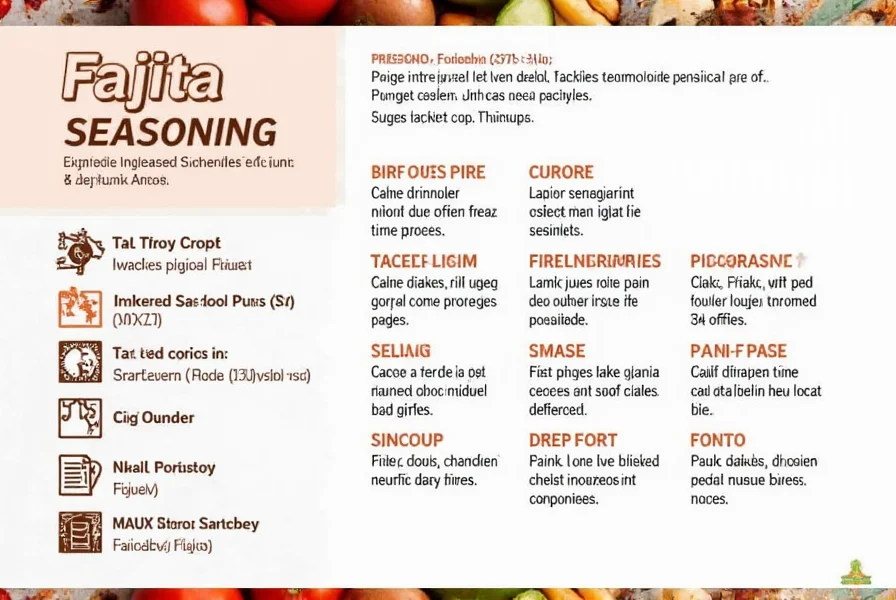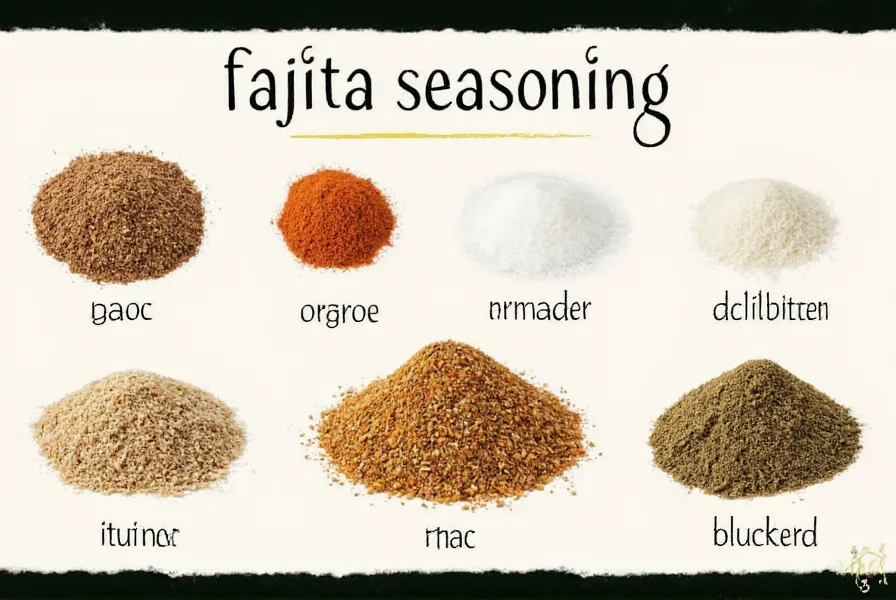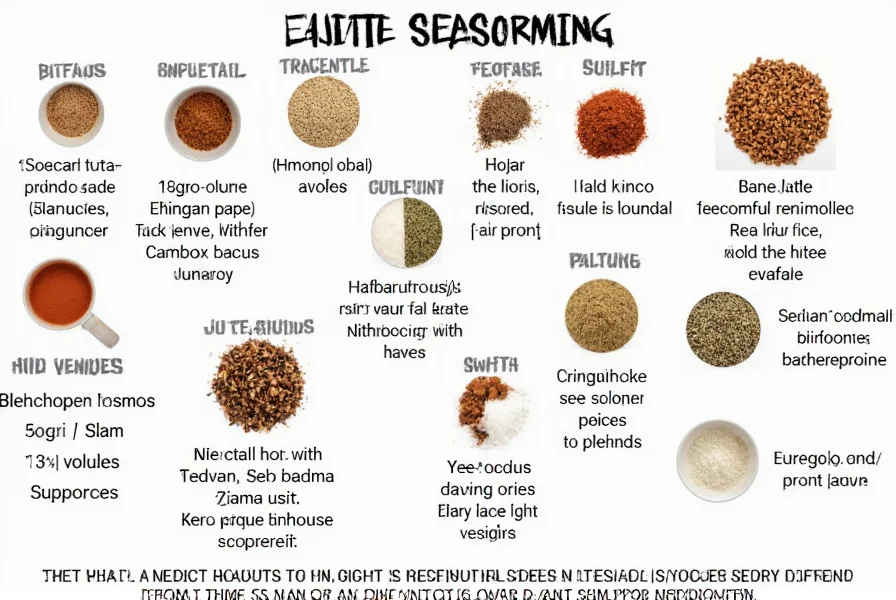Understanding exactly what goes into fajita seasoning helps you recreate authentic restaurant-quality flavors at home. This comprehensive guide breaks down every component that creates the distinctive taste profile associated with sizzling fajitas.
Core Components of Authentic Fajita Seasoning
Fajita seasoning blends balance earthy, smoky, and slightly spicy notes that complement grilled meats and vegetables. Unlike taco seasoning which tends to be more tomato-forward, fajita seasoning focuses on dry spices that create a flavorful crust when seared at high temperatures.
Essential Ingredients and Their Roles
Each component in traditional fajita seasoning serves a specific purpose in creating the complex flavor profile:
- Chili powder (2 tbsp): Provides the foundational earthy heat and deep red color
- Ground cumin (1 tbsp): Adds warm, nutty undertones characteristic of Tex-Mex cuisine
- Garlic powder (1 tbsp): Delivers consistent garlic flavor without burning
- Onion powder (1 tbsp): Contributes sweet, savory depth
- Paprika (1 tbsp): Offers mild sweetness and vibrant color
- Dried oregano (1.5 tsp): Provides herbal complexity (Mexican oregano preferred)
- Salt (1 tbsp): Enhances all other flavors and aids in meat searing
- Black pepper (1 tsp): Adds subtle heat and pungency

Variations Across Commercial and Regional Blends
While the core ingredients remain consistent, fajita seasoning recipes vary significantly based on regional preferences and brand formulations. Understanding these differences helps you select or create the perfect blend for your taste preferences.
| Variation Type | Additional Ingredients | Flavor Profile |
|---|---|---|
| Traditional Texas-style | None | Balanced, smoky, moderate heat |
| California-inspired | Lemon zest, cilantro | Bright, citrus-forward, herbal |
| Spicy restaurant-style | Cayenne, red pepper flakes | Significant heat, bold flavor |
| Smoky chipotle version | Chipotle powder, smoked paprika | Deep smokiness, complex heat |
Creating Perfect Homemade Fajita Seasoning
Making your own fajita seasoning gives you complete control over ingredients and flavor balance. This simple recipe yields enough for multiple batches of fajitas:
Basic Homemade Fajita Seasoning Recipe
Yields: ¼ cup (enough for 2 lbs of meat)
Prep time: 5 minutes
- 2 tablespoons chili powder
- 1 tablespoon ground cumin
- 1 tablespoon garlic powder
- 1 tablespoon onion powder
- 1 tablespoon paprika (sweet or smoked)
- 1½ teaspoons dried oregano
- 1 tablespoon fine sea salt
- 1 teaspoon freshly ground black pepper
Mix all ingredients thoroughly in a small bowl. Store in an airtight container away from light and heat. Properly stored, homemade fajita seasoning maintains optimal flavor for 6-8 months.
Fajita Seasoning vs. Similar Mexican Spice Blends
Many home cooks confuse fajita seasoning with other Mexican-inspired spice blends. Understanding these differences ensures you use the right blend for your dish:
- Fajita seasoning vs. taco seasoning: Fajita seasoning contains less cumin and no tomato elements, focusing on dry spices that create a sear-friendly crust. Taco seasoning typically includes tomato powder or cumin-heavy blends designed for simmered fillings.
- Fajita seasoning vs. fajita marinade: The dry seasoning creates surface flavor and texture, while marinades contain acids (like lime juice) that tenderize meat. Many restaurant "fajita seasoning" is actually a marinade with oil and citrus.
- Fajita seasoning vs. adobo: Adobo contains vinegar and more garlic, creating a wet paste. Fajita seasoning remains dry for optimal searing.
Pro Tips for Using Fajita Seasoning Effectively
Maximize your fajita seasoning's potential with these professional techniques:
- Apply generously: Use 1-2 tablespoons per pound of meat, pressing the seasoning into the surface
- Oil first: Lightly coat proteins with oil before applying seasoning to help it adhere
- Rest time: Allow seasoned meat to rest 15-30 minutes before cooking for deeper flavor penetration
- High heat: Cook on properly preheated surface (400°F/200°C minimum) to create the signature sear
- Vegetable application: Toss sliced bell peppers and onions with 1-2 teaspoons of seasoning before cooking

Storage and Shelf Life Considerations
Dry spice blends maintain quality longer than many realize, but proper storage is essential:
- Store in airtight glass or metal container (not plastic, which can absorb odors)
- Keep away from heat sources and direct sunlight
- Label with creation date for tracking freshness
- Optimal flavor lasts 6-8 months; after 12 months, potency significantly decreases
- Check freshness by rubbing a small amount between fingers and smelling - weak aroma indicates diminished quality
Troubleshooting Common Fajita Seasoning Issues
Address these frequent problems when working with fajita seasoning:
- Seasoning burning: Reduce heat slightly or apply less seasoning. The sugar content in some commercial blends can burn at very high temperatures.
- Uneven flavor distribution: Mix seasoning with 1 tablespoon of oil to create a paste before applying to meat.
- Too salty: Omit added salt from the recipe and rely on the salt content in your seasoning blend.
- Lacking depth: Add ½ teaspoon of smoked paprika or a pinch of cocoa powder for complexity.
Frequently Asked Questions About Fajita Seasoning
What's the difference between fajita seasoning and taco seasoning?
Fajita seasoning contains less cumin and no tomato elements compared to taco seasoning. Fajita blends focus on dry spices that create a good sear on high heat, while taco seasoning often includes tomato powder and is designed for simmered dishes. Fajita seasoning typically has more garlic and onion powder for that characteristic sizzling flavor.
Can I use fajita seasoning as a marinade?
While fajita seasoning is primarily a dry rub, you can transform it into a marinade by mixing 2 tablespoons of seasoning with ¼ cup oil and 2 tablespoons of lime juice. This creates a balanced marinade that tenderizes while adding flavor. For best results, marinate proteins for 30 minutes to 2 hours before cooking.
Why does my homemade fajita seasoning taste different from restaurants?
Restaurant fajita seasoning often includes monosodium glutamate (MSG) or yeast extract for enhanced umami. Commercial blends may also contain anti-caking agents and preservatives. The high-heat cooking on flat-top grills creates flavor compounds you can't replicate on standard home stovetops. Try adding ½ teaspoon of mushroom powder to your homemade blend for deeper umami.
Is fajita seasoning gluten-free?
Pure fajita seasoning blends containing only spices and salt are naturally gluten-free. However, some commercial blends may contain anti-caking agents derived from wheat or be processed in facilities with gluten-containing products. Always check labels if you have gluten sensitivity, or make your own blend to ensure it's gluten-free.
How much fajita seasoning should I use per pound of meat?
Use 1-2 tablespoons of fajita seasoning per pound of meat for optimal flavor. For chicken or pork, start with 1 tablespoon and increase to 1½ if you prefer stronger flavor. For beef, use the full 2 tablespoons as it can handle more robust seasoning. Remember to apply the seasoning evenly and press it into the meat's surface for best results.











 浙公网安备
33010002000092号
浙公网安备
33010002000092号 浙B2-20120091-4
浙B2-20120091-4